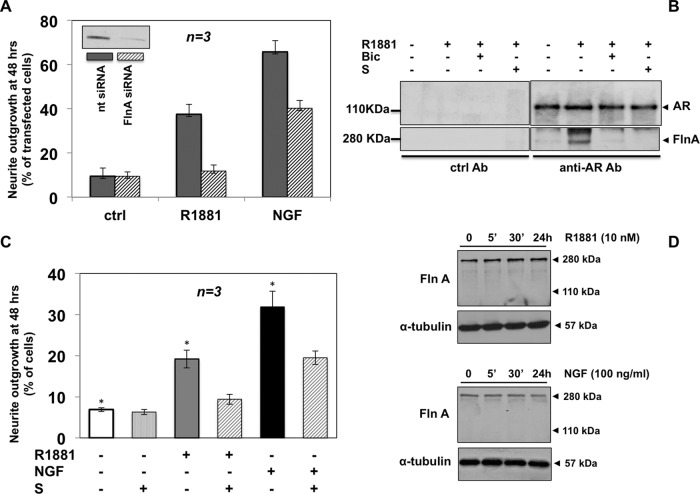FIGURE 5:
Role of FlnA and its association with AR in neurite outgrowth induced by R1881 or NGF. PC12 cells were used. (A) Growing cells on polylysine-coated coverslips were transfected with FlnA siRNA or nt siRNA. Purified pEGFP plasmid (Amaxa) was included to help identification of transfected cells. Cells were made quiescent and then left unchallenged or challenged for 48 h with R1881 (10 nM) or NGF (100 ng/ml). In GFP-expressing cells, neurite outgrowth was analyzed by contrast phase microscopy and expressed as percentage of transfected cells. Several coverslips were analyzed, and data from at least 150 scored cells for each coverslip were collected and are graphically shown. Inset in A shows FlnA protein levels detected by Western blot of lysate proteins from PC12 cells transfected with nt or FlnA siRNA. After silencing, residual FlnA expression was ∼20%, as calculated by ImageJ software. (B) Quiescent cells were left untreated or treated for 5 min with the indicated compounds: R1881 at 10 nM, bicalutamide (Bic) at 10 μM, and S peptide at 1 nM. Lysate proteins (2 mg/ml protein) were immunoprecipitated with nonspecific (ctrl Ab) or anti-AR antibodies (C-19 Ab). Proteins in immune complexes were analyzed using antibodies against the indicated proteins. The C-19 Ab was used to detect AR. (C) Quiescent cells on polylysine-coated coverslips were left untreated or treated for 48 h with 10 nM R1881 or 100 ng/ml NGF in the absence or presence of S peptide (1 nM). Neurite outgrowth in plastic-plated PC12 cells was evaluated and is expressed as percentage of total cells. In A and C, means and SEM are shown. In C, the statistical significance of results was also evaluated by paired t test. The difference in neurite outgrowth was significant (*p < 0.05) only between cells challenged with R1881 or NGF and unstimulated cells. (D) Quiescent cells were left untreated or treated for the indicated times with 10 nM R1881 (top) or 100 ng/ml NGF (bottom). Lysate proteins were analyzed using antibodies against the indicated proteins.

